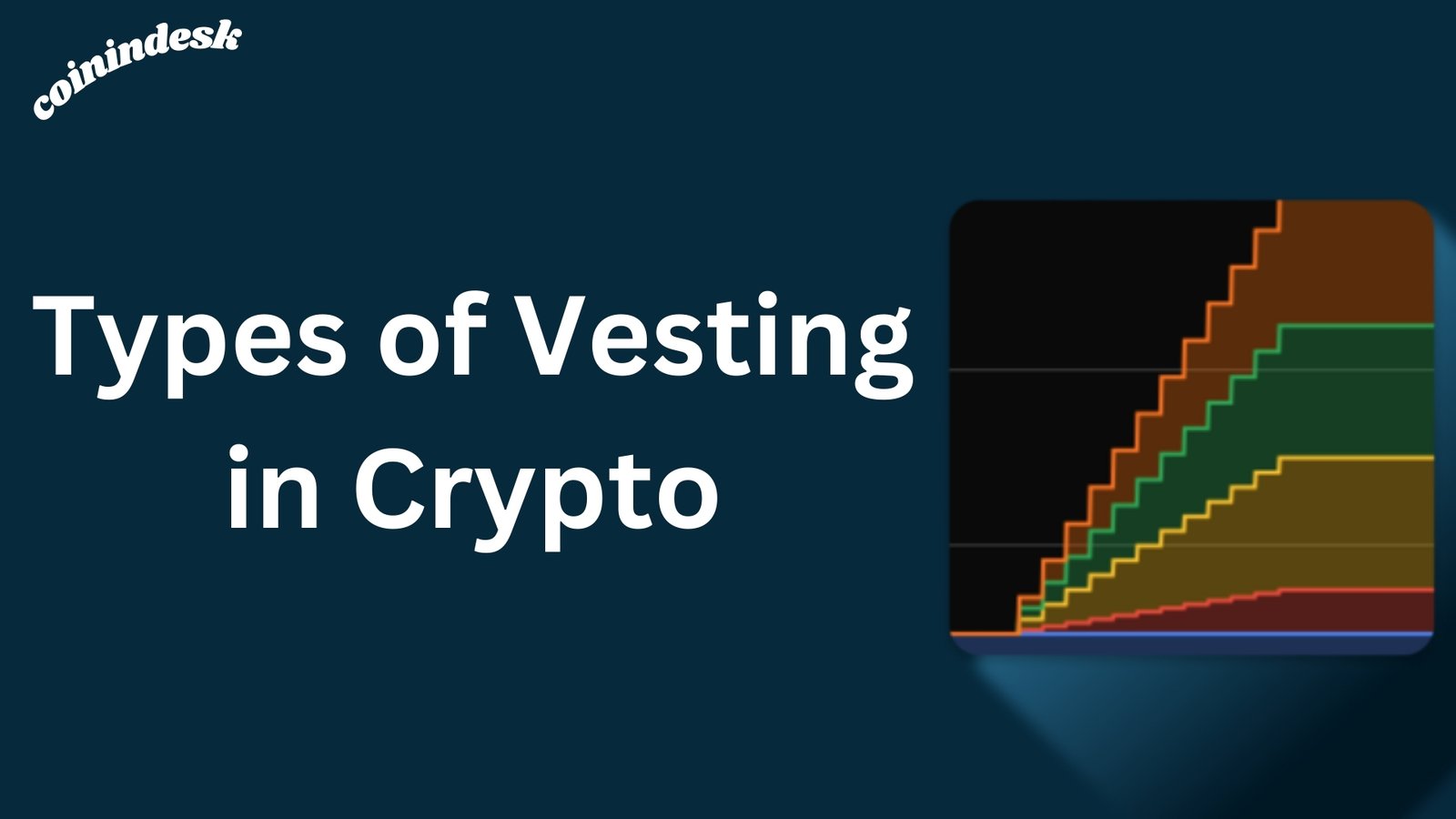Crypto vesting limits the access or transfer of cryptocurrency tokens or coins to their holders for a set period before releasing them completely. It finds widespread application in token sales, initial coin offerings (ICOs), and other cryptocurrency fundraising endeavours. Crypto vesting is an effort to discourage short-term gains at the expense of long-term commitment, thereby discouraging team members or early investors from cashing out too quickly. Token holders are granted access to their tokens over time, typically at prearranged intervals, known as a vesting period.
Vesting schedules can and do change, but generally, they have a cliff (a waiting period) and regular release periods. For example, tokens could be released monthly after a one-year cliff.
Smart contracts on the blockchain are typically used to implement vesting, ensuring the rules are clear and applied automatically. This technique demonstrates the dedication of key players to the project’s long-term success, which helps establish trust among the community and investors.
After a token’s vesting time ends, several ways exist to release it. Here, tokens that were locked for a set period are unlocked. Because of this, unlocking usually occurs in increments or phases, allowing owners to gain access to their assets over time gradually. Achieving performance indicators, reaching milestones, or following a time-based timetable are all possible release criteria.
Types of Vesting in Crypto

The different types of vesting in the crypto space include time-based, milestone-based, hybrid, and reverse vesting.
Time-based vesting
Token holders with time-based vesting will receive their tokens in increments over a predetermined period. For example, Ethereum’s vesting structure for early investors is time-based. Tokens issued in an ERC-20 format, such as those given to founders during a crowdsale, can be progressively vested through several publicly available smart contracts. However, “raw” Ether (ETH), which differs from wrapped Ether, does not have a comparable method for vesting.
When people refer to “raw Ether,” they typically mean the native cryptocurrency on the Ethereum blockchain that hasn’t been modified. It is not tokenized or wrapped like Ethereum on the Ethereum network or ERC-20 tokens on other networks, which are representations of Ethereum on different blockchains. Certain features and smart contracts aren’t compatible with the original Ethereum, and there are fewer options for vesting compared to tokenized assets.
Milestone-based vesting
Token distribution is contingent upon achieving specific project goals or milestones via milestone-based vesting. Some blockchain projects consider a vesting system tied to team members and partner milestones. For instance, a portion of the token supply could be distributed when a specific feature is fully operational, a protocol upgrade is completed, or a significant project milestone is achieved.
Hybrid vesting
When you combine time-based and milestone-based vesting, you get hybrid vesting. When distributing tokens, blockchain projects frequently use a hybrid vesting scheme. Over time, the team and earliest backers will receive tokens according to a vesting schedule. At the same time, the completion of specific project milestones is dependent on another component. This two-pronged strategy acknowledges dedication over the long haul and achieves key milestones in harmony with project goals.
Reverse vesting
In “reverse vesting,” the recipient may lose ownership of tokens they originally received if certain conditions aren’t met. This is the inverse of the usual vesting process. Users of Filecoin’s Simple Agreement for Future Tokens (SAFT) could take advantage of reverse vesting.
To encourage long-term network alignment, mining incentives are provided according to a schedule. To help miners financially, 25% of block rewards are paid out immediately, and 75% vest progressively over 180 days. Additional Filecoin (FIL) tokens will be distributed to the Protocol Labs teams and the Filecoin Foundation over a six-year period, while SAFT investors will receive their tokens over three years.
Crypto Vesting vs. Traditional Financial Vesting Models
Traditional financial vesting employs centralized administration to achieve the same objectives within the conventional business structure, whereas crypto vesting utilizes blockchain technology for automation and transparency. Due to the unique character of assets built on the blockchain, cryptocurrency vesting models exhibit both shared and distinct characteristics with more conventional financial vesting models. Smart contracts built on the blockchain enable the automated and transparent implementation of vesting rules in the cryptocurrency sector.
The fundamental goal of crypto vesting is to ensure that stakeholders’ interests (including investors, advisors, and project teams) align with the project’s long-term growth and success. Stock options and restricted stock units (RSUs) are examples of equity-based compensation arrangements commonly linked to vesting in traditional finance. In contrast to crypto vesting, which often employs smart contracts on decentralized platforms, traditional vesting methods are usually administered through centralized systems by businesses and financial institutions.
In conventional finance, there is often a waiting period before employees or executives own the shares they have been granted entirely. This is known as time-based vesting. Giving long-term employees a bonus will help retain them. Performance-based stock programs may use milestone-based vesting, which releases shares only after meeting corporate goals, albeit this is rare in conventional finance.
How does Vesting Affect Token Supply?
Token vesting controls the dilution of the token supply and market dynamics by releasing tokens into circulation in a controlled manner. It affects the total supply of tokens in circulation since it regulates the amount purchased on the market. Typically, tokens tied to the vesting process need some time to enter circulation or be traded.
This is why these tokens are not considered part of the supply until they are entirely vested. Reduced circulating supply throughout the vesting period impacts market capitalization and available liquidity. When tokens unlock or vest according to predetermined schedules or conditions, they become part of the circulating supply. This can affect the supply-and-demand balance in the ecosystem, investor mood, and market dynamics.
Benefits of Crypto Vesting

Smart contracts enable crypto vesting, which boosts investor trust by securely aligning stakeholder interests with a project’s long-term performance in an open, flexible, and transparent manner. In the blockchain industry, crypto vesting has multiple advantages. Token holders’ confidence is bolstered by the automated and transparent enforcement of vesting rules made possible by smart contracts in decentralized networks.
Time- or milestone-based vesting systems provide investors, teams, and advisers a long-term stake in project success. FUD in Crypto vesting enables projects to customize their systems, fostering responsibility and commitment. Blockchain technology enhances the process’s security because it eliminates the need for a central authority to influence it. Regarding it, crypto vesting is a must-have for boosting investor confidence, minimizing speculative behaviour, and encouraging long-term project development.
Risks Associated with Crypto Vesting
Crypto vesting has obstacles such as balance incentives, regulatory uncertainty, smart contract weaknesses, liquidity issues, and a lack of standardization. While crypto vesting provides much-needed incentives, it is not without its challenges and dangers. There may be legal issues with enforcing vesting contracts due to regulatory uncertainties in the emerging cryptocurrency ecosystem.
Code errors and smart contract vulnerabilities could lead to unforeseen consequences or security breaches, jeopardizing token holdings. The market can experience sudden fluctuations or sell-offs when vested tokens are unlocked due to the associated liquidity risk.
Additionally, if vesting procedures vary across projects, investors may become confused. Striking the right balance between rewarding hard work and guaranteeing a successful project is an ongoing challenge. Legal, technological, and market-related considerations must all be carefully considered to navigate the intricate crypto vesting process.
FAQs
1. What is crypto vesting, and why is it used?
Crypto vesting restricts token access for a period to encourage long-term commitment and reduce early sell-offs.
2. What are the main types of crypto vesting?
Vesting types include time-based, milestone-based, hybrid, and reverse vesting—each with distinct release conditions.
3. How does vesting impact token supply and price?
Vesting delays the entry of tokens into circulation, affecting liquidity and market dynamics by controlling supply dilution.
4. How are smart contracts involved in crypto vesting?
Smart contracts automate vesting schedules on the blockchain, ensuring transparency, fairness, and tamper-proof execution.
5. What risks are associated with crypto vesting?
Risks include smart contract bugs, regulatory uncertainty, sudden liquidity shifts, and inconsistent project implementations.


